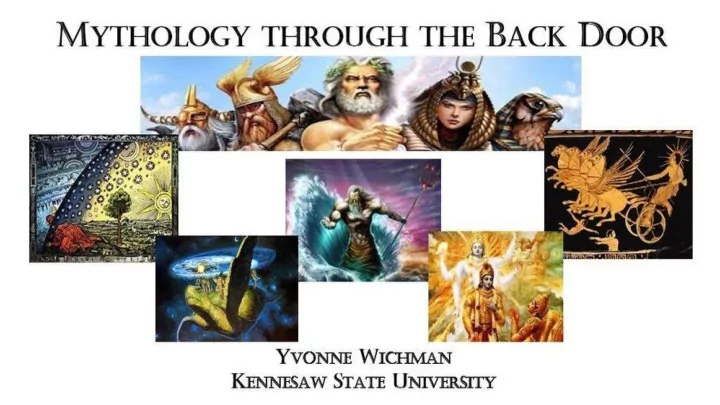

Six strategies toward a better understanding of myth as a field of study: Define myth--what it is and what it is not. Clarify the purposes and functions of myth. Explain how myths originate and are shaped. Detail why and how people believe in myths. Analyze how myths have been interpreted over the centuries. Explore the relationship of oral and written narratives. Professor Ron Smith, “ Teaching Mythology at College Level”
Research Project: Students will study research methodology through a series of assignments related to the process of inquiry. The following are the research components associated with your project: Proposal-informal yet cohesive briefing on the topic. Annotated Bib-ten potential sources in annotated format. Thesis/Outline-concise statement/overview of objective. Abstract-brief summary of intended scope of research project. Research Paper-ten page paper fulfilling all requirements. Documentary-five minute multimedia presentation of paper.
A few examples of my students’ topics: “Mythology Buried in Catholicism: What the Church Doesn’t Tell You !” “Mithras and Jesus Christ: Copycat Religions or Absolute Truth?” “How Mythology Caused the Downfall of the Aztec Civilization” “Mythology Hidden in the Hallowed Halls of Hogwarts” “The Matrix: A Mythological Masterpiece”
“I have always thought that the stories we were told when we were growing up shaped us. Now I know that they, the stories, did shape us. Stories are the way humans have survived for thousands of years. People have always used myths to explain the unexplainable. We still do that today, but I think we have lost touch with how myths are supposed to be generated — by word of mouth. Myths are the stories we tell, the stories of the people, told from people to other people. These are the stories of our past and our future. ” Kimberly - age 19
“Campbell points out that myths cannot necessarily control how we live our lives, but we can relate to them anyway. He says, “When the story is in your mind, then you see its relevance to something happening in your own life. It gives you perspective on what’s happening to you. ” I believe this is true. Myths can help explain what is going on in your life. But people do not share myths anymore. Myths offer morals of what is right and wrong. If no one is telling these stories anymore, then people stop learning important lessons about life. ” Tyler - age 18
“Joseph Campbell says, “Life is pain; life is suffering; and life is horror — but by God, you are alive. ” I really enjoyed reading this because it gives me hope for my life. My parents divorced when I was young. My dad was never around, so my Mom is everything to me. She gave me everything she could. You can be going through some rough times, trying to live one day at a time, thinking that it is just not worth it, but that IS life. Life IS suffering. If you are suffering then you are ALIVE. Campbell’s thoughts are just so profound. ” Brandon - age 19
KSU students who embraced MYTHOLOGY and its relevance in their lives!
References Armstrong, Karen. A Short History of Myth. Canongate, 2005. Campbell, Joseph. The Hero with a Thousand Faces . Princeton University Press, 1968. Campbell, Joseph, and Bill Moyer. The Power of Myth. Ed. Betty Sue Flowers, Double Day, 1988. Earthman, Elise Ann. “ The Siren Song That Keeps Us Coming Back.” The English Journal, vol. 86, no. 6, 1997, pp. 76-81. Frauenfelder, David . “Popular Culture and Classical Mythology.” The Classical World, vol. 98, no. 2, 2005, pp. 210-213. Kitchell, Kenneth F. “The Role of Myth Courses on College Campuses.” The Classical World, vol. 98 no. 2, 2005, pp. 187-192. Parker, Laura. “School science debate has evolved.” USA Today , 18 Nov. 2004, p. 3. Sartore, Richard L. “The Link between Mythology and Education.” The Clearing House, vol. 65, no. 1, 1991, p. 35-36. Smith, Grace P. “Vitalizing Mythology.” The Classical Journal, vol. 14, no. 2, 1918, pp. 128-131. Smith, Ron . “Teaching Mythology at College Level.” Rocky Mountain MLA Annual Meeting, Salt Lake City, UT. 22 Oct. 1982. Staley, Gregory A. “Myth and the Classical Tradition.” The Classical World, vol. 98, no. 2, 2005, pp. 206-209. Tigue, John W. “Teach Mythology as a Subtext of the Humanities.” The Journal of General Education, vol. 41,1 992, pp. 23-31. Warner, Marina. Six Myths of Our Time . Random House, 1994.
Recommend
More recommend